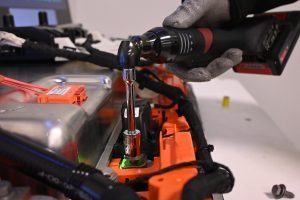
Supply chain challenges, workforce shortages, and inflationary pressures such as rising energy costs and increasing raw material prices, have had a significant impact on the manufacturing sector in recent years. Now, economic indicators are pointing to a reduction in GDP, which raises the question: Are we in a recession? And what does this mean for manufacturers if we are?
Jay Timmons, CEO of the National Association of Manufacturing (NAM), says, “Through multiple crises, manufacturers have proven remarkably resilient, but there’s no mistaking there are darker clouds on the horizon. A majority of our surveyed members believe inflationary pressures are making a recession more likely within the next year.”
Despite the prospects of an economic slowdown, manufacturers remain optimistic with more than 82% of NAM survey respondents maintaining a positive outlook.
To understand what this means for the future of manufacturing, we’re exploring what historical data indicates about the industry’s ability to bounce back from a down market and three strategies industry experts say can help manufacturing leaders build resilience in their processes and operate more efficiently and profitably.
Manufacturing in a Recession
Historically, manufacturing has been more susceptible to recessionary forces than other sectors of the economy—but it’s worth noting the industry has experienced faster recovery periods, as well.
Forbes reports that between the recession of the early 2000s and the Great Recession of 2008, industrial manufacturers experienced 300% higher recoveries in corporate profits compared to companies in other sectors. This boom in production led to economic growth across all industries and helped propel the economy out of recession.
According to Randy Wolken, President and CEO of the Manufacturers Association of Central New York, manufacturers must make adjustments to navigate through recessions. He states, “Well-led manufacturers who prepare their teams for recessions do much better and emerge more quickly from these downturns. Downturns are a natural part of the market cycle, and the more prepared a company can be heading into a downturn, the more likely it will survive and thrive during the recovery.”
3 Things Resilient Organizations Do Differently
Conventional wisdom would lead companies to cut back during a recession by scaling back investments and restructuring staff. But the recent past shows us that innovating in the face of adversity can give manufacturers a competitive advantage, positioning them for greater growth when the economy warms back up. Whereas remaining stagnant further stalls growth.
Companies that focus on improving productivity through better use of talent and equipment and optimizing operations by investing in technologies that increase efficiency and productivity, can improve their ability to compete, both in the short and long run. This makes manufacturers more resilient and responsive to the needs of customers, helping them build loyalty and gain market share.
Here are three ways resilient manufacturers are positioning their organization for continued growth.
1. Invest in the Future
According to analysis by Deloitte, a basic instinct is to cut back on capital investments and wait the recession out. But for companies that invested in technology during the years leading up to a recession, the analysis reports, “These manufacturers observed much higher revenue growth in the recovery following a manufacturing downturn.”
Industry experts suggest adding Industry 4.0 technologies and investing in process improvements and critical employees. Digital transformation can also help improve organizational resilience and responsiveness to customers. For example, augmented reality (AR) stands out as an innovative technology that has been proven to deliver a 90% improvement in quality and a 50% improvement in throughput across many industries and applications.
Manufacturers that implement process improvement technologies can now expect short-term gains in quality, efficiency, and productivity that have long-term dividends.
RELATED ARTICLE: 6 Uses of Augmented Reality for Manufacturing In Every Industry

2. Invest in Your Workforce
Research from Deloitte also shows that retaining and building talent is a high-impact disruptive factor to the future of manufacturing. To ensure capacity can be met to meet demand as the economy recovers, companies should enact strategic plans for talent acquisition. According to an article by OEM magazine, companies should “hold onto their talent, as layoffs could come back to hurt a company more than the downturn itself.”
Taylor St. Germain, an analyst for ITR Economics is quoted in the OEM magazine article, saying, “The tight labor market we are feeling right now is here to stay for the next few years. It’s important that we keep those A and B players in our business right now. As things pick up, we are going to need those people in our business because it’s tough to find them as it is right now.”
To improve employee retention and quickly train new workers, companies should consider integrating assistive technologies such as projected AR, which have been proven to increase training effectiveness by more than 30%. By projecting work instructions directly onto any work surface, assistive technologies such as AR help simplify complex manual processes and make it easier and faster to train, upskill and cross-train employees. This reduces the ramp-up time for new and reassigned employees and empowers them to hit their productivity and quality goals from day one.
RELATED: 3 Effects of the Skills Gap on the Bottom Line
3. Enhance Your Supply Chain
When it comes to strengthening the supply chain, resilient manufacturers are focused on:
- Diversifying supply chains
- Maintaining leaner, more efficient inventories
- Optimizing production operations to generate more and waste less
Manufacturers with just-in-time global supply chains encountered problems during the COVID-19 pandemic. By allocating resources to build new supply chains, manufacturers can better handle the risks of international supply disruptions and drive economic growth in their communities.
A recession is also a good time to develop “smart partnerships” with reliable companies to deliver mission-critical services that help lower costs and maintain or improve reliability. These partnerships can range from modern technology to a partner that directly optimizes operations or an external partner that helps with the logistics and transportation of goods.
It’s important to establish connections with partners that do their due diligence to prevent challenges (especially related to supply chain issues) by investing in process improvements and technologies. For example, augmented technologies, such as projected AR, can be used to standardize and streamline processes for increased productivity and quality to guarantee the delivery of goods on time, within budget, and to standard.
Build a Resilient Manufacturing Strategy
Perhaps the fourth way to win in a recession is to stay optimistic because every challenge offers possibilities for the future. Recessions in manufacturing come and go, and companies that invest in talent, equipment and technology now will have a competitive advantage over those that don’t. Gains made in efficiency and quality today will enable manufacturers to become more resilient during market downturns and more responsive to customers’ needs, resulting in greater customer loyalty and market share.
Interested in learning how leading manufacturers are using industrial augmented reality for process improvement, quality assurance, and workforce development? Send us a message to schedule a consultation with our AR experts.

